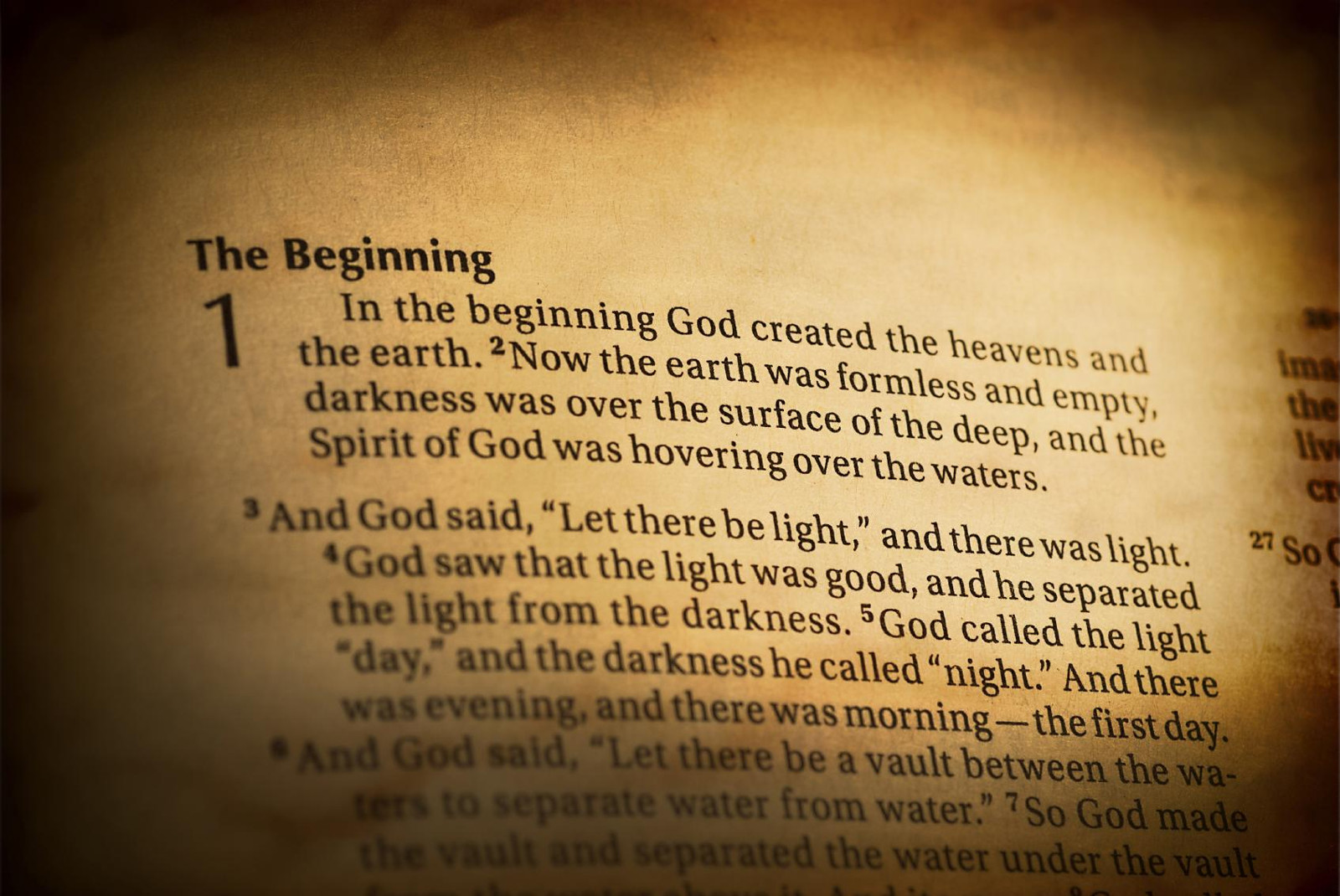Coming to Grips with the Early Church Fathers’ Perspective on Genesis, Part 4 (of 5)
Lee Strobel opens his book The Case for Christ by describing a criminal case that he covered as the legal editor for the Chicago Tribune.1 James Dixon was accused of shooting a Chicago police sergeant. There were eyewitnesses, a motive, and the injuries on the officer. They even found Dixon’s gun with one bullet fired. To add to it all, Dixon actually confessed. An open-and-shut case. Or was it? It took two words—“pen gun”—from an informant to turn the entire case upside down. (A “pen gun” is a small gun disguised as a simple pen.)
The officer’s injury was self-inflicted when the pen gun in his pocket discharged accidentally. Possession of this kind of weapon is illegal, so Dixon had been framed as part of a cover up. After reexamination, everything that seemed to argue so powerfully for the man’s guilt was suddenly reinterpreted in light of the new evidence to argue for his innocence. For Strobel, this case epitomized his journey from hard-boiled skepticism to a genuine belief in Jesus Christ as he investigated the facts for himself. For me, this is the perfect illustration for how a seemingly rock-solid case for young-earth creationism in the early church crumbles after learning just a few key details.
The specific case that I’m reviewing is made by James Mook in chapter 1 of Coming to Grips with Genesis. His objective is to demonstrate that the early church supports modern young-earth creationist claims. In parts 2 and 3 of this series, I discussed how the early church was divided on the nature of the creation days. Clement of Alexandria, Origen, and Augustine—all leaders who employed allegorical interpretation—clearly rejected a calendar-day view and instead believed the creation “days” occurred instantaneously.
Since the church fathers were clearly divided on the interpretation of the days of creation, Mook shifts his focus to the age of the earth where he can show that there was widespread agreement among the church fathers that the earth is very young (less than 6,000 years old). Many of the fathers, including allegorical interpreters, taught this specific view. (By my own research, none of the fathers taught an old earth.2) Mook concludes, “Allegorical interpreters among the fathers were especially remarkable in resisting the old-earth theories of their day.”3 Mook sees this agreement between the allegorists and those he deems “literalists” as proof that the church was united in rejecting the idea that the earth is billions of years old. Taken together, Mook’s evidence seems to lend strong support for viewing the fathers as young-earth creationists.
As if that is not enough, Mook then plays his ultimate trump card: “Another strong proof of the young-earth creationism of the Church fathers is their sex/septa-millennial view that the earth was less than 6,000 years old.”4 This refers to a popular belief among the fathers that Jesus Christ would set up his millennial kingdom on the six thousandth year after creation.5 Those holding to this framework would have had to believe the world was less than 6,000 years old; hence, Mook’s claim that the patristic fathers were young-earth creationists. Surely, this is an open-and-shut case. Or is it?
Creation-Week Pattern for Human History
What Mook names the sex/septa-millenary construct, I prefer to call the creation-week pattern for human history. This view posits that the creation week of Genesis 1 serves as a template for God’s plan for humanity. God created the world in six “days” (regardless of the nature of those “days”), so human history would also span six “days,” each 1,000 years long, based on Psalm 90:4 (“…a thousand years in your sight are like a day…”).6 Taken together, all of post-creation history would encompass exactly 6,000 years. This would be followed by a seventh millennial “day” (paralleling the Sabbath rest) that the church identified with Christ’s millennial kingdom. After this, the “eighth day” starts, marking the inauguration of the new creation.7 Mook documents that at least eight fathers seem to have taught this millennial framework.8 Robert Bradshaw, a young-earth creationist whom I mentioned in part 1, also provides an extensive discussion of this view and includes additional names.9
The exact origin of this model is uncertain but it seems to have arisen in Jewish circles perhaps a century or two before Jesus’ time. It’s likely that this model developed, at least partially, out of the apocalyptic ferment of the time. With Israel under the control of the Greeks and later the Romans, apocalyptic literature emphasized God’s sovereign control over all things—including history. Having a clear formula for when God would act on behalf of his people encouraged faithfulness amid such chaotic times.
This particular six-thousand-year framework was popular among Jewish rabbis, who further subdivided it into three 2,000-year periods: the age of chaos, the age of the law, and the age of the Messiah.10 To put this in context, some early Jewish sources placed creation around 4000 BC.11 Using that as a start point, the age of the law would have begun with Abraham around 2000 BC and the Messiah would inaugurate the messianic age in the early first century. For the apocalyptic writers of the first and second century BC living under foreign domination, the promise of the Messiah coming soon to rescue them was enormously encouraging. Thus, this framework was popular even though it was not derived from a literal interpretation of Scripture.
Christians later adopted this model. Since the church used the Greek Septuagint instead of the Hebrew text, they generally thought creation occurred around 5600–5500 BC.12 The church then used the creation week framework to predict Christ’s return on the six thousandth year (rather than his coming on the four thousandth, as the Jewish rabbis had taught). The seventh millennium (paralleling the Sabbath rest) was identified with Jesus’ millennial kingdom. All of this had important eschatological implications because it predicted that the end times would be around the fourth century.
Starting with Eusebius in the fourth century, the date for creation was revised to around 5200 BC, pushing Christ’s return back three hundred years. Apparently, this was done to cool eschatological fervor.13 As time went on, age estimates continued to be adjusted to stay within the six-thousand-year framework. In his own research, Bradshaw writes, “For the purposes of our present study the important point to note is that it was ecclesiastical concern over eschatology rather than arguments that the world was more ancient that caused these changes.”14
In the fifth century, Jerome’s Latin Vulgate translation restored the ages at fatherhood (in the Genesis genealogies) given in the Hebrew text. So as the Vulgate became accepted, dates for creation subsequently shifted to around 4000 BC. Following the Jewish model, scholars placed Jesus’ first coming around the four thousandth year, but this placed his second coming in what was then the far future (around 2000 AD).
Not surprisingly, the creation-week pattern waned in popularity during the Middle Ages, since it no longer predicted Christ’s return as imminent. Interestingly, James Ussher and John Lightfoot revived this pattern in the mid-seventeenth century by assigning 4004 BC as the date for creation. That date is no accident because it placed Jesus (c. 4 BC) exactly four thousand years after Adam. Its popularity was assured because Christ’s second coming would again be expected to be only a few centuries away.
Analysis
Much of this discussion may seem to provide Mook with substantial support for his claim that the fathers were young-earth creationists. However, a closer examination reveals a more complex story.
- Nonliteral origin. Scripture does not teach the chronological framework or the idea of the world lasting just 6,000 years. Instead, this model is based on typological comparison rather than a literal one. (Ironically, Mook does acknowledge that the creation-week pattern involves “typological interpretation” but does not admit this fact makes the framework nonliteral.)15 Additionally, the use of Psalm 90:4 to equate a day to a millennium is not hermeneutically justified and is, therefore, not a literal interpretation.16 (In part 3, I discussed a variety of non-allegorical—yet still nonliteral—modes of interpretation popular in the early church.) While the Bible certainly does teach that Jesus will return, it does not in any way affirm this particular eschatological model.
- Popular tradition only. Mook appeals to the fact that this 6,000-year model was widely held (by at least 8 fathers) as strong support for his contention that the fathers were young-earth creationists. But popularity does not determine truth. Many popularly held beliefs are later rejected. For example, many of the early church fathers taught that Isaiah 14 and Ezekiel 28 were written about Satan, but Martin Luther and later theologians correctly pointed out that these passages refer primarily to the kings of Babylon and Tyre.17
- Emphasis on eschatology. The creation-week framework set up an absolute timeline for understanding history (past and future). If one was able to date backward to creation, then one could work forward to determine when certain key events would happen. For the church, this meant a way to predict Christ’s return, while for the Jews it pointed to the coming of the Messiah. Lactantius—one of the fathers Mook mentions—went so far as to incorporate this idea into his discussion on the end times (The Divine Institutes 7.14–25). Historically, we see that both this model and the age estimates were flexed to achieve the desired goal—a sense of immanence for the next step in God’s plan.18
- Constrained interpretations of Genesis. Mook focuses on the fact that even the allegorical interpreters (e. g., Origen and Augustine) taught that the world was young. For him, that suggests that the age of the earth was the pivotal issue. What he misses is that this framework (which is just human tradition) prevented any church father from even considering the earth to be older than 6,000 years. In other words, no one could hold that the creation days were long periods of time or that there might be significant gaps in the Genesis genealogies because that would not fit within this millenary construct and, thus, would be perceived as denying Christ’s return.19 So, for those who rejected a calendar-day interpretation of Genesis 1, there was no room to even consider a position other than instantaneous creation. The patristic fathers’ failure to teach an old earth should not be construed to mean this idea is incompatible with Scripture.
Conclusion
Mook devotes many pages to documenting the creation-week pattern for human history (or sex/septa-millenary construct) and its popularity among the church fathers. For him, it is the crowning argument for his claims of early young-earth creationism. The irony is that while many indeed saw the earth as young, the view was driven primarily by human tradition. It is incorrect, therefore, to conclude that the young-earth view in the early church is grounded on a literal interpretation of Genesis—in fact quite the opposite. As such, the popularity and consistency of young-earth creationism in the early church is almost entirely artificial and so should not be construed as supporting modern young-earth creationism. We would be better served by reassessing Genesis 1–11 for ourselves rather than relying on the early church for direction on this issue.
My complete work on this topic is currently unpublished. Inquiries regarding it should be directed to [email protected].
This article is Part 4 (of 5) of “Coming to Grips with the Early Church Fathers’ Perspective on Genesis”.
To access additional parts, please click below:
Part 1 | Part 2 | Part 3 | Part 4 | Part 5
Endnotes
- Lee Strobel, The Case for Christ (Grand Rapids, MI: Zondervan, 1998), 9–13.
- Let me offer two minor caveats. First, Origen actually wrote that the “world is not yet ten thousand years old, but very much under that” (Against Celsus 1.19) but this statement can be understood as being consistent with a 6,000-year framework. Second, Philo (a Jewish scholar not discussed by Mook) is unique in rejecting attempts to date the origin of the world (Questions and Answers on Genesis 1.1). While this leaves open the possibility that he would be open to an old-earth, there is no actual evidence to suggest that he actually was. John Millam, “The Genesis Genealogies,” Reasons To Believe, accessed September 28, 2010, https://www.reasons.org/files/non-staff-papers/The-Genesis-Genealogies.pdf.
- James Mook, “The Church Fathers on Genesis, the Flood, and the Age of the Earth,” in Terry Mortenson and Thane H. Ury, eds., Coming to Grips with Genesis (Green Forest, AR: Masters Books, 2008), 32.
- Ibid., 39.
- Ibid., 38–48.
- Justin Martyr (Dialog with Trypho, A Jew 81) and Irenaeus (Against Heresies 5.23.2) are sometimes mistakenly cited as teaching long creation days on the basis of equating “day” with a thousand years. This is a common error and we see it, for example, in Hugh Ross, A Matter of Days (Colorado Springs, CO: NavPress, 2004), 43. A day as a thousand years was never applied to the creation days themselves, only to post-creation history.
- The idea of the “eighth day” seems to be drawn mainly from a misunderstanding of the headers of Psalms 6 and 12. The Hebrew word sheminith is likely a musical term but was translated “eighth” in the Greek Septuagint as used by the church fathers. In addition, Jesus’ resurrection on the first day of the week could also be viewed as an eighth day (i.e., the first day of the second week) and so prefigured the new creation on the eighth day.
- James Mook, “The Church Fathers on Genesis, the Flood, and the Age of the Earth,” 40–48. According to my own study, 11 out of the 50 church fathers and 2 out of the 30 Jewish sources taught this framework. John Millam, “The Genesis Genealogies.”
- Bradshaw, chapter 3, table 3.2.
- Bradshaw, chapter 3.
- There were a number of attempts to date back to creation using the genealogies of Genesis 5 and 11. The ages at fatherhood in these genealogies as given in the Greek Septuagint were noticeably older than the actual values given in the Hebrew text. Using the Septuagint, the early church arrived at distinctly different estimates compared to Jews following the Hebrew. In the end, these age estimates are not rigorous and rely on a lot of assumptions, and are, therefore, should not be used in attempts to determine the age of the earth. For complete documentation and analysis, see John Millam, “The Genesis Genealogies.”
- See previous footnote.
- Robert I. Bradshaw, Creationism and the Early Church, last updated January 25, 1999, chapter 3, https://www.robibradshaw.com/contents.htm.
- Ibid.
- James Mook, “The Church Fathers on Genesis, the Flood, and the Age of the Earth,” 39.
- Psalm 90:4 is clearly a simile (a comparison using “like” or “as”) to illustrate that that which we would consider a very long period of time (a thousand years) is to God like a brief period of time (a day or a watch in the night). Nothing in this or any other passage remotely suggests that we can equate a solar day to a millenium.
- Bradshaw, Creationism and the Early Church, chapter 8.
- The creation-week framework changed and evolved over time, as has already been described. (1) Jewish rabbis, following the Hebrew values in Genesis 5 and 11, placed the Messiah’s coming in the four thousandth year. (2) Early church fathers (first three centuries), following the Septuagint values, held that Jesus would return on the six thousandth year. (3) Church fathers of the fourth and fifth centuries suggested a younger age for the earth to postpone expectations of Jesus’ return. (4) Later theologians, following the Vulgate (and hence the Hebrew values), restored the idea of the Messiah coming on the four thousandth year and placed his return on the six thousandth.
- John Millam, “The Genesis Genealogies,” Reasons To Believe, accessed September 28, 2010,https://www.reasons.org/files/non-staff-papers/The-Genesis-Genealogies.pdf.
Dr. John Millam
Dr. Millam received his doctorate in theoretical chemistry from Rice University in 1997, and currently serves as a programmer for Semichem in Kansas City.






